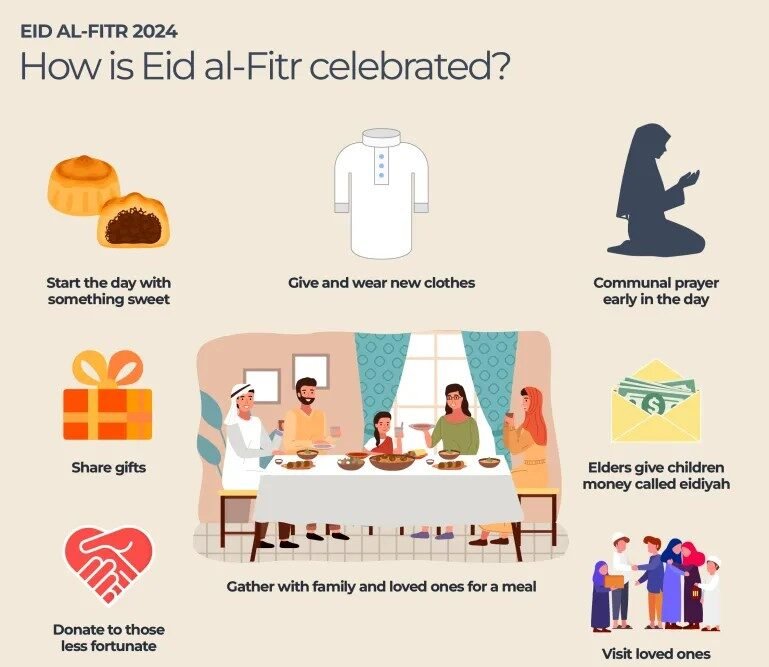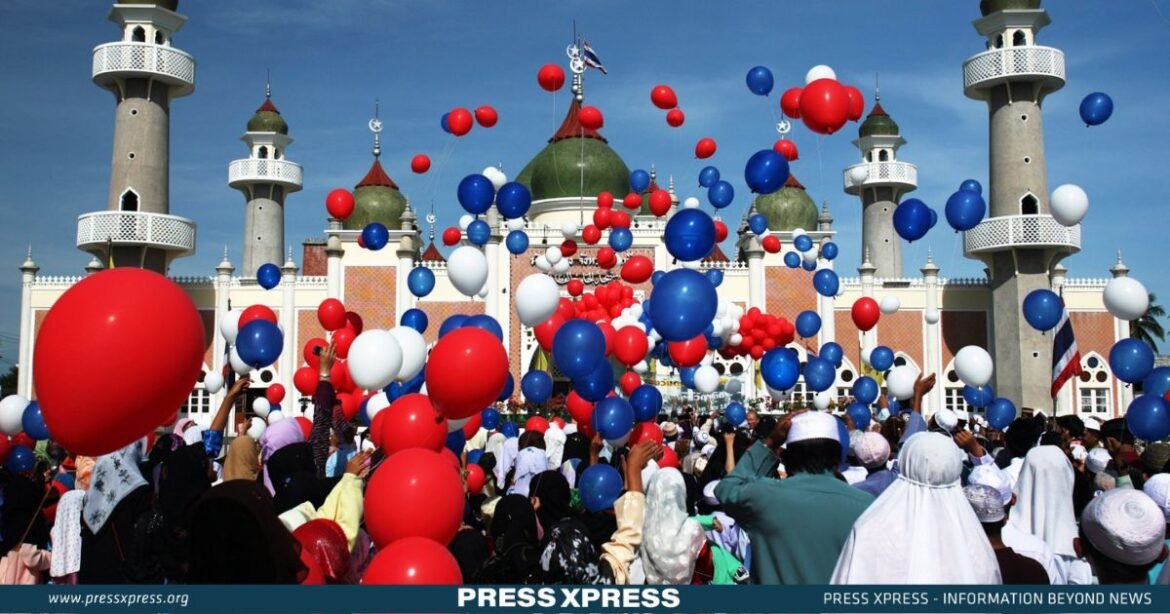Key Highlights:
- One of the core traditions of Eid ul Fitr is the act of charitable giving, known as Zakat al-Fitr
- In West Java, Indonesia, Muslims from across the nation congregate by the serene banks of the Cisadane River to observe Eid ul Fitr prayers
- In South Asia, the custom of ‘Eidi’– the giving of monetary gifts to children
As the sun dips below the horizon, Muslims worldwide turn their gaze skyward, seeking the delicate crescent of pale white light that marks the culmination of the Islamic holy month of Ramadan, etched into the night sky. Commencing and concluding with the appearance of the new moon, Ramadan aligns with the ninth month of the Arabic lunar calendar and the tenth month is Shawwal whose first day is marked as Eid-ul-Fitr around the world.
From dawn to dusk, Muslims observe a fast, refraining from food, drink, and behaviors such as gossip and falsehoods for a month. Beyond mere abstinence, Ramadan serves as a period of introspection, urging individuals to reflect on their actions and intentions while also fostering empathy and generosity towards those in need.
But, have you ever wondered how Eid-ul-Fitr is celebrated across different corners of the world? From the streets of Istanbul to the serene villages of Indonesia, each locale adds its unique flavor to the festivities. What delicacies are prepared to tantalize taste buds during this auspicious occasion? Do colorful bazaars come alive with vibrant textiles and ornate decorations? And what about the joyous gatherings where laughter mingles with the echoes of prayers?
Here’s a look at how it is celebrated around the world:

One of the core traditions of Eid ul Fitr is the act of charitable giving, known as Zakat al Fitr. This practice requires Muslims to donate a specific amount of food or money to the less fortunate, ensuring that everyone can partake in the joyous celebrations. In countries like Indonesia, the world’s largest Muslim-majority nation, families often donate rice, flour, or other staple foods to local mosques, which then distribute the items to those in need.
The importance of family bonds is another integral aspect of Eid ul Fitr. Across the Muslim world, it is common for people to gather with their loved ones, exchange gifts, and indulge in traditional delicacies. In the Middle East and South Asia, the tradition of visiting elderly relatives and seeking their blessings is deeply rooted in the festivities. Similarly, in South Asia, the custom of ‘Eidi’– the giving of monetary gifts to children – is a cherished practice that strengthens familial ties.
Celebration Across South Asia
The South Asian region harbors a substantial Muslim populace, constituting a notable proportion of the overall population. In India, Muslims represent around 14.2% of the total populace. Pakistan boasts a Muslim majority, comprising 96.2% of its population, while in Bangladesh, Muslims make up 90.4%. Sri Lanka also hosts a significant Muslim community, accounting for approximately 7.6% of its population.

These large Muslim populations contribute to the grandeur and scale of Eid ul Fitr celebrations across South Asia. In India, for instance, the festival is marked by the distribution of sheer khurma, a delectable vermicelli pudding, and the wearing of traditional attire like kurtas and salwar kameez. In Pakistan, the festival is celebrated with great enthusiasm, with the popular practice of ‘Chand Raat’ (the night of the new moon) when women apply henna (mehndi) on their hands and gather to dance and sing.
Bangladesh, on the other hand, is renowned for its vibrant Eid fairs, where people indulge in traditional games, rides, and the purchase of handmade goods. Sri Lanka, with its diverse Muslim community, showcases a unique blend of South Asian and Middle Eastern influences in its Eid celebrations, including the preparation of elaborate biryani dishes and the gifting of traditional sweets.
Eid’s Melting Pot Around the Globe
In West Java, Indonesia, Muslims from across the nation congregate by the serene banks of the Cisadane River to observe Eid ul Fitr prayers. The picturesque riverside setting enhances the profound spiritual atmosphere of the occasion.
Adorned in traditional garments, participants revel in the vibrant hues of their attire, marking the culmination of Ramadan. Indonesia boasts the world’s largest Muslim population, with an estimated 205 million followers, constituting approximately 88% of its populace.
In Turkey, ‘Bayram Şekeri’ is a cherished tradition, featuring the exchange of special candies and sweets.
Malaysia’s ‘open house’ tradition invites guests into homes for a lavish spread of traditional dishes, fostering unity.
During ‘Bajram Bayrami’ in the Balkans, households are beautified with flowers and candles, establishing a peaceful setting.
West Africa’s Eid ul Fitr celebrations feature lively ‘Takossari’ parades with vibrant traditional attire and rhythmic drumming.
In Beijing, Chinese Hui Muslims light incense at the historic Niujie Mosque after Eid prayers, gathering at this Yuan Dynasty landmark. China’s constitution recognizes Islam as one of five approved religions, with Hui Muslims comprising nearly half of the country’s 23 million Muslims.
Amidst the Eid ul Fitr festivities in London, Muslims traverse the paths of Regent’s Park, adding to the tapestry of a multicultural affair that emphasizes solidarity and the ongoing cultural evolution within a city experiencing a demographic shift with its expanding Muslim community.

Eid’s Sweet Trail
While prayers and communal gatherings are central to Eid, food plays a significant role in the celebrations. Different countries have their favorite sweet treats and culinary traditions:
- Turkey: During Eid, traditional Turkish sweets such as Baklava and Turkish delight are exchanged as cherished gifts.
- Iraq and Saudi Arabia: Dates, symbolizing prosperity and blessings, are central to Eid celebrations, accompanied by Kleichas, rose-flavored biscuits filled with nuts and dates, enjoyed by many.
- Yemen: Bint al sahn, a delectable honey cake adorned with nigella seeds, holds a special place among Yemeni sweets during Eid.
- Russia: Eid tables in Russia feature Manti, flavorful dumplings filled with seasoned meat, delighting the taste buds of celebrants.
- China: You Xiang, crispy flour patties fried in oil, serve as delightful gifts or delectable treats enjoyed during the festive feasting.
- Bangladesh: Eid gatherings in Bangladesh are adorned with Korma and savory pittas, shared joyfully among family and friends, enhancing the spirit of togetherness.
Eid is more than just a time for feasting and merriment. It is a time for reflection, for strengthening family bonds, and for extending a hand of generosity to those in need. And as the echoes of prayers mingle with the laughter of loved ones, let us embrace the spirit of Eid not just for a day, but for every day, as we strive to build a world filled with compassion, understanding, and peace. Eid Mubarak!


